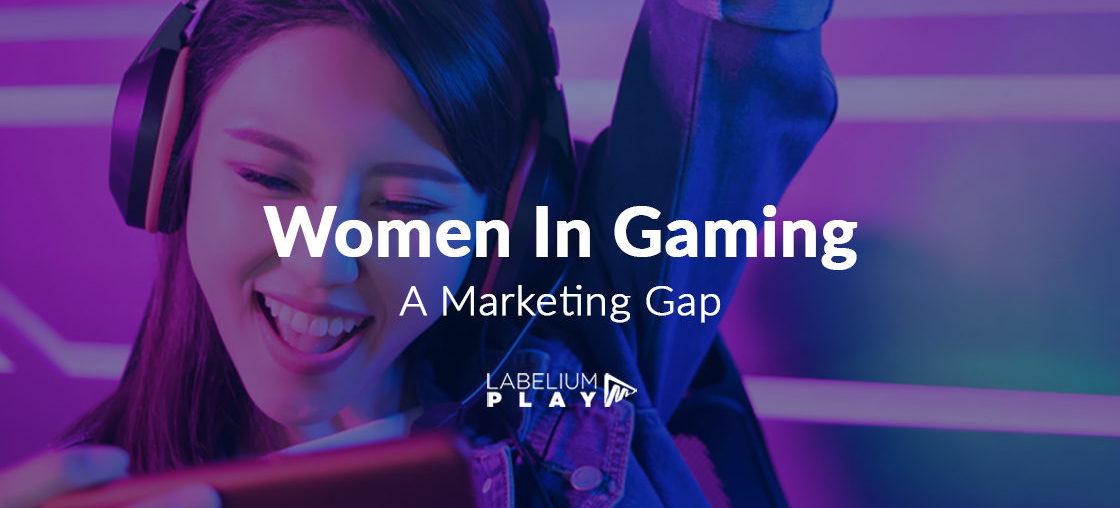Our experts have compiled the newest information on the current state of the gaming industry as it pertains to Women in Gaming, and provide recommendations on how your brand can rise to the occasion.
According to a recent report by the International Advertising Bureau, the gaming industry is currently bigger than the music and film industry combined, at an estimated worth of $174.9billion. Formerly perceived as a male-dominated space, the gender mix is nearing par, thanks to the rising popularity of mobile hyper-casual games and the ubiquity of gaming offerings. Although women’s gaming sessions are on average 25% longer than their male counterparts and despite their propensity to spend more on in-app purchases, as many as 62% of female self-identified gamers feel that brands don’t market to them. This creates a big marketing gap into which forward-thinking brands can rise to the occasion.
How your brand can leverage the gap
- Sponsor female eSports teams and personalities
- Promote inclusivity for Women in Gaming
- Sell in-game items which appeal to females in Gaming
- Look to mobile
- Sponsor female eSports teams and personalities
With 26.5 million daily viewers and 35% female viewership on popular streaming platform Twitch, brands can positively insert themselves into the cultural conversation by cultivating an inclusive brand image. eSports are currently gaining entire teams and leagues of female gamers. Livestream videos will likely attract more female viewers with increased female participation, leading to higher sponsorship values for advertisers. All-female tournaments, such as the For-The-Women (FTW) showdown, are also a perfect opportunity for sponsors to widen their target audience. As one of the first big US companies to make a foray, Bumble, an online dating platform with more than 65 million users worldwide, sponsored the first all-female eSports team named “Team Bumble” within “Gen.G,” a well-known global eSports organization. The all-female squad competed on Fortnite to see about 2.3 million people on the game’s live stream.
2. Promote inclusivity for Women in Gaming
Due to the misconception that gaming has a male-dominated gamer base, gender-based favoritism expresses itself in higher salaries, prizes, and sponsorships for men. As a recent example, Dreamhack Valencia’s 2019 all-female eSports tournament offered a USD 100,000 prize, a record number for the female eSports world. In contrast, the male-dominated International 2019’s DOTA tournament had a whopping USD 34 million prize pool. Women gamers are often evaluated on their gender rather than their skills, being sexualized and harassed by online trolls. Yet among these grim facts, one golden opportunity stands out: the brands that take initiatives to address this issue will be the champions of the fast-growing female gamer demographic. Big US companies are taking note: Facebook recently launched Women in Gaming. This platform wants to foment diversity and inclusion in the gaming industry by bringing together women to share their experiences.
3. Sell in-game items which appeal to females in Gaming
In-game modification items such as skins (cosmetic alterations to the player’s characters) are highly popular. As they are infinitely replicable, the cost of creating them nears 0 the more are sold. Thus, they are also an effective tool to drive conversions:
High-end cosmetics brand MAC released five co-branded, limited-edition lipsticks in collaboration with Chinese mobile conglomerate Tencent’s game “Arena of Valor” to be purchased in-game. The results were overwhelmingly positive: Consumers placed over 14,000 pre-orders, and all five lipstick styles sold out within 24 hours.
4. Look to mobile
Mobile gaming accounts for about 90% of all digital gamers, according to a recent report by eMarketer, making it the most popular medium by far. Its high accessibility can explain its overwhelming popularity – mobile devices are ubiquitous today. Moreover, its games have low entry points due to their design, and consumers can play games anywhere. The COVID-19 pandemic has also contributed to mobile’s popularity, cementing new habits in mobile gamers who are expected to play longer sessions than pre-pandemic, giving brands more opportunities to reach their target audience.
Adding to mobile game’s irresistible universal appeal, female gamers account for 63% of the market. They sustain mobile gaming sessions that are on average 25% longer than their male counterparts, providing both more customers and customer touchpoints. Moreover, they tend to spend more during these sessions on in-game items, making them an attractive target to drive revenue.
“Intrinsic in-game advertising on mobile devices has proven to be extremely impactful and memorable to gamers.”
Cary Tilds, Chief Strategy and Operations Officer at Frameplay.
“Intrinsic in-game advertising on mobile devices has proven to be extremely impactful and memorable to gamers,” said Cary Tilds, Chief Strategy and Operations Officer at Frameplay. “We recently conducted four Comscore blind brand lift studies with four major insurance, snack, condiment, and fast food brands. The results exceeded expectations, with double point brand lifts in mobile brand recall, the likeability of the sponsorship in-game, and purchase intent. These results clearly illustrate that mobile intrinsic in-game advertising positively influences purchasing decisions of consumers.”
This is a great opportunity, as brands can chart new paths and potentially reap the rewards of untapped markets. Working closely and developing deep partnerships with game developers and publishers when developing a marketing strategy will be beneficial to formulate a creative, as these two entities know their audience and game mechanics best. The sky’s the limit – Developers can code anything into games.
Need a quick introduction to the world of Gaming? Read our starter guide to Advertising in Gaming here: https://www.labelium.com/blog/advertising-in-gaming/
Labelium Play has a team of experts who know the gaming world’s ins and outs. Reach out today to see how you can capture the gaming market and expand your target audience!






